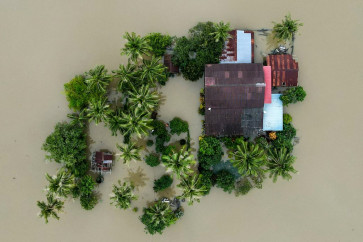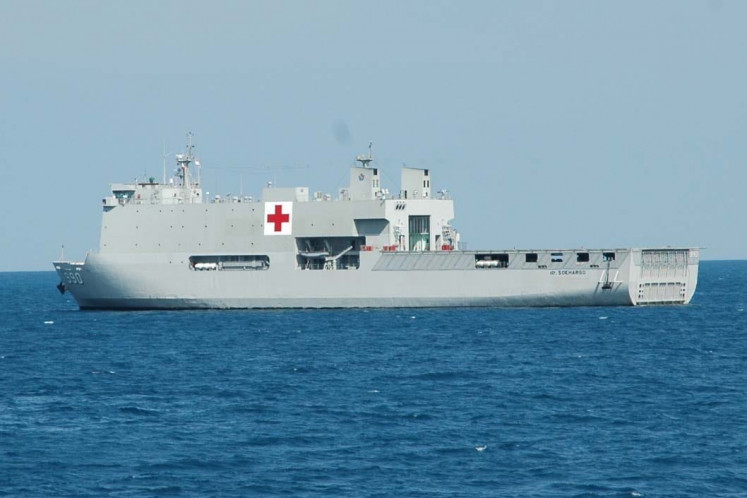Popular Reads
Top Results
Can't find what you're looking for?
View all search resultsPopular Reads
Top Results
Can't find what you're looking for?
View all search resultsNusantara as a smart, innovative and green city
The President envisions Nusantara as an innovation hub. It will be the focal point of improvements to the country’s economic development in health care, education and business.
Change text size
Gift Premium Articles
to Anyone
I
t has been a long time coming. The idea of a built-from-scratch capital dates to Sukarno in 1957 when he inaugurated Palangkaraya, now the capital of Central Kalimantan. The much-venerated founding father had envisioned a capital outside of Java in part as a development countermagnet.
Sixty-five years and two major regime changes later, President Joko “Jokowi” Widodo is finally preparing to deliver the vision of his inaugural office holder. On Tuesday this week, the House of Representatives approved the passage of Jokowi’s bill for the establishment of Nusantara, the future capital of Indonesia.
Home to more than 20 million, Greater Jakarta is one of the world’s oldest urban areas, struggling with the weight of exponential growth, worsening traffic congestion, bad air quality and annual flooding. It is also the fastest sinking population center in Southeast Asia.
Some argue that Jakarta’s environmental woes make it unfit to represent Indonesia’s bright future. The relocation of the capital to Nusantara will rebalance the growth, redistribute wealth and keep ecological footprints at sustainable levels.
Having consulted officials from Japan, the United Kingdom and Abu Dhabi, President Jokowi envisions Nusantara housing up to 7 million residents, featuring world-class amenities and some of the most innovative approaches to urbanism in Southeast Asia. Following the House’s approval, National Development Planning Minister Suharso Monoarfa said Nusantara would be a standard bearer, the identity of the nation, as well as a new economic growth pole.
Kalimantan is rich in minerals and natural resources, although deforestation due to palm oil plantations and timber operations have compromised the otherwise pristine rain forest. It is also home to exotic fauna such as orangutans, long-nosed monkeys, sun bears, rhinos and other endangered species.
A unique and strategic plan is needed to ensure creative city planning while considering the preservation of the existing culture as well. The government has already stated that its aim is to not disturb any of the natural forest or its living mechanisms but to rehabilitate it.
In contrast, Java is home to nearly 60 percent of the country’s population and over 80 percent of its economic activities, Kalimantan is four times larger, and its population density is 38 times lower than that of Java.
This allows for the development of Nusantara as a bio city which will produce multiple socioeconomic and environmental benefits. It lowers per capita carbon emissions, and by densifying the total structure of the area we have more space for productivity, innovation and better infrastructure. President Jokowi stated that this location was very strategic for all purposes and that it would relieve the pressure put on Jakarta.
The new city’s design and urban planning need to be smart, innovative and futuristic in creating a congenial relationship between man and nature. The design should focus on ecological modernization, keeping the city pollution free, ensure the use of electric vehicles and deploying artificial intelligence for the best possible living standards.
The proposed master plans for Nusantara include a transit system that consists of an electric tram to match that of Jakarta’s MRT system. This city is to promote walkability in all respects, and the government hopes to reduce the heat island effect that occurs in clustered Jakarta. Other technological advancements to be included are drone service for delivery and monitoring of the whole city.
This is a huge step forward and will promote healthy lifestyles, especially after witnessing the impacts of COVID-19. The total area of the new project is around 632,580 acres, some four times the size of the current capital.
The President also envisions Nusantara as an innovation hub. It will be the focal point of improvements to the country’s economic development in health care, education and business. Jokowi wants a change in the system, and the new city should represent an economic transformation in all areas.
The government has estimated that the total cost of the new capital will be around US$34 billion (Rp 466 trillion), which will mostly cover the future presidential palace and other government buildings. With strong financial cooperation with the international community – ranging from the World Bank to Japanese Softbank and the United Arab Emirates sovereign wealth fund – the new capital could break ground any day.
The urban design will need to bring forward the rich cultural heritage of Indonesia. Buildings representing the three coequal branches of government, the Presidential Palace, House of Representatives and the Supreme Court in the north, as well as the business district, will be centrally located following the layout of Washington, DC.
A lot can be learned from the experiences that neighboring Malaysia and Myanmar had in shifting their national capitals. The ongoing pandemic will also offer insights on Nusantara becoming a resilient city and the new measures to be taken to support it. It has raised questions on how society will operate once again and what protocols should be followed to ensure safety for everyone. The only aspect we can say for sure from this current situation is that people should be more aware of their actions in public and have better hygiene practices incorporated into their lifestyles.
Everyone, particularly the young people of Jakarta, are hoping that Nusantara will provide a promising creative future for the country. A lot can be learned from the problems Jakarta has faced over the decades, such as its overall architecture, its use of green space, its urban planning and its overconsumption of resources.
New futuristic designs, when implemented, will provide an opportunity for Nusantara to lead Asia, which is home to 45 percent of the world's young people. Cities that succeed in creating a natural ecosystem of safe streets, attractive amenities, good schools, clean air, picturesque parks and vibrant cultural opportunities will become magnets for an increasingly mobile workforce – and, as result, for employers, too.
This is key to unlocking Indonesia’s bright future. Young talent attracts capital far more effectively than the other way around. Great cities of the past, like Jakarta, were built around rich natural resources: a deep harbor, a wealth of minerals and an abundant yet depletable fuel supply.
Today, great new cities are being built around people and the benefits of technologized amenities, which will continue to grow. As such, a smart, innovative and green Nusantara presents an unprecedented opportunity to build Indonesia anew.
***
Adhityan Anbumozhi is an architectural graduate student at Syracuse University in New York. Harya S. Dillon has a doctorate degree in urban planning and public policy from the University of California, Irvine, and is a 2009 Fulbright scholar.










